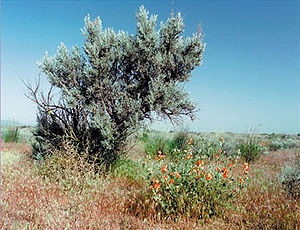Sagebrush
| Sagebrush | ||||||||||||
|---|---|---|---|---|---|---|---|---|---|---|---|---|

Sagebrush at its natural site in Washington |
||||||||||||
| Systematics | ||||||||||||
|
||||||||||||
| Scientific name | ||||||||||||
| Artemisia tridentata | ||||||||||||
| Nutt. |
Desert mugwort ( Artemisia tridentata ) (English common name : Sagebrush), also called steppe mugwort or desert sage , is a species of plant in the Asteraceae family.
The English name of sagebrush, sagebrush, is also used for some related species of the genus Artemisia , for example for the California mugwort .
Occurrence
This hardy plant species grows in arid areas of the western United States , especially in the vast, desert-like areas of the Great Basin . A small population exists in Middlesex County in the US state of Massachusetts on the east coast of the USA. It is also widespread in the Canadian province of British Columbia and northwestern Mexico . The sagebrush grows on both sandy and loamy soil.


Description and ecology
The sagebrush is a silvery-gray round shrub or small tree that reaches an average height of about 1.20 meters. Along rivers or in other relatively humid areas it can grow up to 3 meters high.
Similar to sage , it gives off an aromatic odor, especially when wet. However, it is not related to the sage. Unlike him, it tastes bitter. Presumably this smell is used to deter animals.
The leaves of the sagebrush are wedge-shaped and attached to the branches at the thin end. The other, wider end is usually divided into three - sometimes two or four - wings. The leaves are covered with fine silvery hairs, which keep the leaves cool and minimize water loss. Most of the leaves do not fall off in autumn or winter, as they usually grow in areas where rainfall is greater in winter than in summer.
The flowers of the sagebrush fall down by the end of summer at the latest. The cup-shaped inflorescences contain only three to eight flowers. The flowers are yellow. The pappus is 1 to 2 millimeters long.
In contrast to most of the other plant species in its range, the roots of the sagebrush are not fire-resistant. After a fire, it can only grow again if the wind blows seeds into the burned area. The roof brine has strongly penetrated the habitat of the sagebrush. It can possibly cause a fire cycle that recurs too often for the sagebrush to find time to settle again.
Systematics
Artemisia tridentata was in 1841 by Thomas Nuttall in Transactions of the American Philosophical Society , Series 2, Volume 7, Page 398 first described . Few botanists assign it as Seriphidium tridentatum (Nutt.) WAWeber to a separate genus Seriphidium .
According to Leila M. Shultz in the Flora of North America, four subspecies can be distinguished:
- Artemisia tridentata subsp. parishii (A. Gray) HM Hall & Clements (Syn .: Artemisia parishii A. Gray ): It occurs in Arizona, California, Nevada, Utah and Mexico (Baja California).
- Artemisia tridentata Nuttall subsp. tridentata (Syn .: Artemisia angustifolia (A. Gray) Rydberg ): It occurs in Alberta, British Columbia; Arizona, California, Colorado, Idaho, Montana, Nevada, New Mexico, Oregon, Utah, Washington and Wyoming in front. The chromosome number is 2n = 18, 36 or 38.
- Artemisia tridentata subsp. vaseyana (Rydberg) Beetle (Syn .: Artemisia vaseyana Rydberg ): She comes in British Columbia; California, Colorado, Idaho, Montana, Nevada, North Dakota, Oregon, South Dakota, Utah, Washington and Wyoming at altitudes between 2000 and 2800 meters. The chromosome number is 2n = 18, 36, or 54.
- Artemisia tridentata subsp. wyomingensis Beetle & AM Young (Syn .: Artemisia tridentata var. wyomingensis (Beetle & AM Young) SL Welsh ): It occurs in Arizona, California, Colorado, Idaho, Montana, Nebraska, Nevada, New Mexico, North Dakota, Oregon, South Dakota, Utah, Washington and Wyoming before. The chromosome number is 2n = 36.
Use and importance
Mugwort contains valuable substances such as proteins for cattle feed , but also oils such as artemiseol, which are poisonous for the symbiotic bacteria in the rumen of many ruminants . If the cattle cannot find any other food in winter, they will eat sagebrush leaves. The poison of the leaves kills the bacteria in the rumen of the cattle that are needed for digestion, thus disrupting the digestive process . Since this is essential for the necessary warmth, the cattle freeze to death. Sheep can tolerate mugwort leaves to a limited extent, especially young seedlings in spring. Pronghorns are the only larger herbivores that eat the sagebrush extensively. Mugwort hens feed 70 to 75% of the flowers and leaves of the sagebrush. For the North American dwarf rabbit , mugwort is the main food.
For many North American Indians , sagebrush is one of the most sacred plants. They burn him in ceremonies, believing that this will keep away evil spirits and purify the mind. Some tribes, such as the Northern Shoshone , also used it to build huts. In addition, the prairie foot is one of the most important incense that they use in their rituals for various purposes such as a. to drive away evil spirits, to spiritually cleanse their ceremony places as well as in the sweat lodge ceremony.
The sagebrush is the national flower of the US state Nevada .
swell
Individual evidence
- ↑ a b c d e Description in the Flora of North America. (English)
- ^ GRIN Taxonomy for Plants. Artemisia tridentata Nutt. In: Germplasm Resources Information Network. United States Department of Agriculture - Agricultural Research Service, Beltsville Area, accessed December 23, 2011 .
- ↑ a b c Artemisia tridentata at Tropicos.org. In: IPCN Chromosome Reports . Missouri Botanical Garden, St. Louis
- ↑ Desert Sage (sagebrush). Retrieved March 16, 2016 .
Web links
- Description in the Flora of North America. (English)
- United States Department of Agriculture (English)
- What is Sagebrush? ( Memento from February 19, 2007 in the Internet Archive )
- Entry in Plants for a Future. (English)
